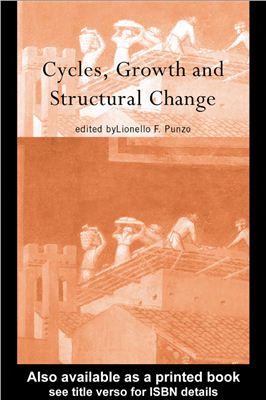Routledge, 2001. 381 p.
With its unique combination of theoretical models and empirical analyses, this collection of specialists’ essays contributes to an assessment of our understanding of the relationship between cycles, growth and structural change. In this light it also offers a critical evaluation of results in the recent literature on complex and chaotic dynamics. The book is constructed upon the hypothesis that a re-unification of the economic analyses of dynamic phenomena can be obtained through comparison and cross fertilization of their up-to-now specialized approaches. Recent developments in economic dynamics, one of the exciting frontiers in current economic research, have been drawing from very diverse research areas and different specialisms: economic theorists, applied economists and econometricians, of course, but also mathematicians and researchers in information theory, time series and dynamical system theories. The variety of approaches in this book well represents the economists’ views of this research area. They range from neoclassical and endogenous growth theories, to classical, evolutionary and neo-Austrian dynamics; from real business cycle and information-based econometrics to other non-linear techniques related to complex dynamics.
Likewise, modelling is done in the macro-, micro-, multi-agent and large dynamical system styles. Moreover, the book offers materials for an evaluation of recent literature which relies on complexity properties to search for alteative formulations of economic policy issues.
Providing both historical evidence and theoretical formulations, written in a critical vein by leading specialists in their own areas, Cycles, Growth and Structural Change offers state-of-the art surveys of a fast expanding field and suggests a research agenda for the future.
Facts and interpretations of growth and fluctuations.
Economic cycles since 1870.
Growth and fluctuations: the post-war Japanese experience.
Productivity–investment fluctuations and structural change.
The macroeconomy and its dynamics.
Qualitative dynamics and macroeconomic evolution in the very long run.
Out-of-equilibrium dynamics.
Disequilibrium growth in monetary economies: basic components and the KMG working model.
Schumpeterian dynamics: a disequilibrium theory of long run profits.
Dynamics by interaction.
Asymmetrical cycles and equilibrium selection in finitary evolutionary economic models.
The instability of markets.
Heterogeneity, aggregation and capital market imperfection.
Toward the microeconomics of innovation: growth engine of market economies.
Challenges for quantitative methodologies.
Business cycle research: methods and problems.
Complexity-based methods in cycles and growth: any potential value-added?
Information, complexity and the MDL principle.
The ‘exogenous’ in ‘endogenous’ growth theory.
With its unique combination of theoretical models and empirical analyses, this collection of specialists’ essays contributes to an assessment of our understanding of the relationship between cycles, growth and structural change. In this light it also offers a critical evaluation of results in the recent literature on complex and chaotic dynamics. The book is constructed upon the hypothesis that a re-unification of the economic analyses of dynamic phenomena can be obtained through comparison and cross fertilization of their up-to-now specialized approaches. Recent developments in economic dynamics, one of the exciting frontiers in current economic research, have been drawing from very diverse research areas and different specialisms: economic theorists, applied economists and econometricians, of course, but also mathematicians and researchers in information theory, time series and dynamical system theories. The variety of approaches in this book well represents the economists’ views of this research area. They range from neoclassical and endogenous growth theories, to classical, evolutionary and neo-Austrian dynamics; from real business cycle and information-based econometrics to other non-linear techniques related to complex dynamics.
Likewise, modelling is done in the macro-, micro-, multi-agent and large dynamical system styles. Moreover, the book offers materials for an evaluation of recent literature which relies on complexity properties to search for alteative formulations of economic policy issues.
Providing both historical evidence and theoretical formulations, written in a critical vein by leading specialists in their own areas, Cycles, Growth and Structural Change offers state-of-the art surveys of a fast expanding field and suggests a research agenda for the future.
Facts and interpretations of growth and fluctuations.
Economic cycles since 1870.
Growth and fluctuations: the post-war Japanese experience.
Productivity–investment fluctuations and structural change.
The macroeconomy and its dynamics.
Qualitative dynamics and macroeconomic evolution in the very long run.
Out-of-equilibrium dynamics.
Disequilibrium growth in monetary economies: basic components and the KMG working model.
Schumpeterian dynamics: a disequilibrium theory of long run profits.
Dynamics by interaction.
Asymmetrical cycles and equilibrium selection in finitary evolutionary economic models.
The instability of markets.
Heterogeneity, aggregation and capital market imperfection.
Toward the microeconomics of innovation: growth engine of market economies.
Challenges for quantitative methodologies.
Business cycle research: methods and problems.
Complexity-based methods in cycles and growth: any potential value-added?
Information, complexity and the MDL principle.
The ‘exogenous’ in ‘endogenous’ growth theory.

